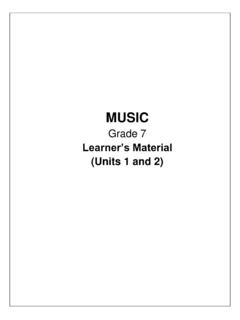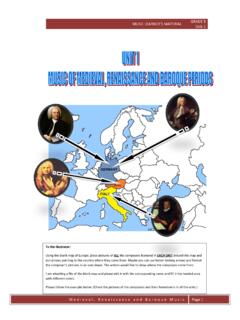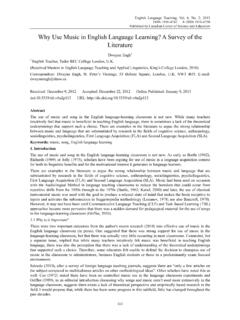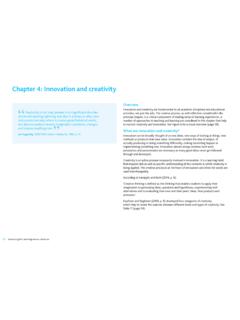Transcription of Music - ASNHS
1 CO_Q2_Music 7_ Module 1 Music Quarter 2 Module 1: Music of the Indigenous People of Luzon and Visayas Music of Cordillera, Palawan, Mindoro, and the Visayas Music Grade 7 Alternative Delivery Mode Quarter 2 Module 1: Music of the Middle Isles of the Philippines ( Music of Cordillera, Palawan, Mindoro, and the Visayas) First Edition, 2020 Republic Act 8293, section 176 states that: No copyright shall subsist in any work of the Government of the Philippines. However, prior approval of the government agency or office wherein the work is created shall be necessary for exploitation of such work for profit. Such agency or office may, among other things, impose as a condition the payment of royalties.
2 Borrowed materials ( , songs, stories, poems, pictures, photos, brand names, trademarks, etc.) included in this module are owned by their respective copyright holders. Every effort has been exerted to locate and seek permission to use these materials from their respective copyright owners. The publisher and authors do not represent nor claim ownership over them. Published by the Department of Education Secretary: Leonor Magtolis Briones Undersecretary: Diosdado M. San Antonio Printed in the Philippines by _____ Department of Education MIMAROPA REGION Office Address : Meralco Avenue, Cor. St. Paul Road, Pasig City, Metro Manila Telephone : (02)863 - 14070 E-mail Address: : Development Team of the Module Author: Jedidiah L.
3 De Leon Content Editor: Emmanuel C. Alveyra Language Editors: Cherrie Rose L. Desaliza, Gladys F. Cantos Reviewer: Emmanuel C. Alveyra Illustrator: Reymark L. Miraples, Louie J. Cortez, Richard Amores, Pablo M. Nizal, Jr., Jan Christian D. Cabarrubias Layout Artist: Reymark L. Miraples, Jhunness Bhaby A. Villalobos Management Team: Benjamin D. Paragas, Mariflor B. Musa, Melbert S. Broqueza, Danilo C. Padilla, Annabelle M. Marmol, Florina L. Madrid, Norman F. Magsino, Dennis A. Bermoy, Emmanuel C. Alveyra 7 Music Quarter 2 Module 1: Music of the Indigenous People of Luzon and Visayas Music of Cordillera, Palawan, Mindoro, and the Visayas Introductory Message This Self-Learning Module (SLM) is prepared so that you, our dear learners , can continue your studies and learn while at home.
4 Activities, questions, directions, exercises, and discussions are carefully stated for you to understand each lesson. Each SLM is composed of different parts. Each part shall guide you step-by-step as you discover and understand the lesson prepared for you. Pre-tests are provided to measure your prior knowledge on lessons in each SLM. This will tell you if you need to proceed on completing this module or if you need to ask your facilitator or your teacher s assistance for better understanding of the lesson. At the end of each module, you need to answer the post-test to self-check your learning. Answer keys are provided for each activity and test.
5 We trust that you will be honest in using these. In addition to the material in the main text, Notes to the Teacher are also provided to our facilitators and parents for strategies and reminders on how they can best help you on your home-based learning. Please use this module with care. Do not put unnecessary marks on any part of this SLM. Use a separate sheet of paper in answering the exercises and tests. And read the instructions carefully before performing each task. If you have any questions in using this SLM or any difficulty in answering the tasks in this module, do not hesitate to consult your teacher or facilitator.
6 Thank you. 1 CO_Q2_Music 7_ Module 1 Lesson 1 Music of the Middle Isles of the Philippines ( Music of Cordillera, Palawan, Mindoro, and the Visayas) Learning Competencies The learner: 1. describes the musical characteristics of representative selections of Cordillera, Mindoro, Palawan and of the Visayas after listening; (MU7LV-IIa-f-1) 2. Explains the distinguishing characteristics of representative Music from Cordillera, Mindoro, Palawan and of the Visayas in relation to its culture and geography; and (MU7LV-IIb-f-3) 3. performs Music from Cordillera, Mindoro, Palawan and of the Visayas with accompaniment. What I Need to Know Activity #1: A Journey to Luzon and Visayas Directions: Imagine that you are on a journey to each of the images below.
7 Write a journal of your supposed experience as you visit each of the locations depicted on the images. Write your answers on a separate sheet of paper. 2 CO_Q2_Music 7_ Module 1 Do you like to travel? Have you ever dreamt of going into far off places and experiencing the culture different from your own? For most people, being able to experience new things is a luxury. Lucky for you, we will be able to experience different kinds of culture in this grading period. From the lowlands of Luzon, we will experience the different culture of Mindoro, Palawan, and Visayas as we unravel their Music . Learning Objectives In this module, we will focus on the elements and characteristics of Music that define the culture of their respective areas.
8 Therefore, at the end of this module, you are expected to: 1. identify different forms of Music (vocal, instrumental, ensemble) as well as the similarities and differences in the musical characteristics between the Music of Cordillera, Palawan, Mindoro, and Visayas; (MU7LV-IIa-f-1) 2. explain the distinguishing characteristics of the Music of Cordillera, Palawan, Mindoro, and Visayas; and (MU7LV-IIb-f-3) 3. sing select songs/chants from the Music of Cordillera, Palawan, Mindoro, and Visayas. (MU7LV-IIa-f-8) What I Know Directions: Read and analyze the following statements. Choose the letter of the correct answer. Write your answers on your activity notebook.
9 1. The Ibaloi Badiw is a vocal genre considered to be the signature form. Where does Ibaloi Badiw belong? A. Mindoro B. Palawan C. Cordillera D. Visayas 2. Which of the following is an epic poetry sang only in four major instances rice harvests, weddings, funerals and wakes? A. Owiwi B. Bua C. Ibaloi Badiw D. Hudhud 3 CO_Q2_Music 7_ Module 1 3. What is the term for a lullaby song of Kalinga tribe? A. Owiwi B. Bua C. Ibaloi Badiw D. Hudhud 4. Which of the following characteristics best defines the Cordilleran Music ? A. Melismatic B. Free Meter C. None of the above D. All of the above 5. Which of the following is a chant Music popular to the Hanunoo Mangyans of Southern Mindoro?
10 A. Ambahan B. Marayaw C. Alangan D. Surat 6. Which of the following is a lute with a bow made of human hair common among the Mangyan tribes? A. Ratagnon B. Gitgit C. Kalutang D. Kudyapi 7. What Mangyan musical instrument is plucked with two strings? A. Ratagnon B. Gitgit C. Kalutang D. Kudyapi 8. What instrument is consisting of a pair of sticks that are struck together to create a rhythm? A. Ratagnon B. Gitgit C. Kalutang D. Kudyapi 9. Which of the following songs from Palawan is a lyrical poem that expresses love? A. Basal B. Bagit C. Tultul D. Kulial 4 CO_Q2_Music 7_ Module 1 10. What chanted Music of Palawan is usually sung at night until morning?









